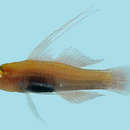Diagnostic Description
provided by Fishbase
This species belongs to the cephalic sensory-pore group 2 with the following characters: lacking only the IT pore, has simple pectoral-fin rays, a dorsal/anal fin-ray formula almost always 8/7, and with the 5th pelvic-fin ray longer than 30% of the length of the 4th ray; however, its abdomen is not black. It is most easily confused with E. prasites and E. spilota (Ref. 89418).
- Recorder
- Cristina V. Garilao
Morphology
provided by Fishbase
Dorsal spines (total): 7; Dorsal soft rays (total): 8; Analspines: 1; Analsoft rays: 7
- Recorder
- Cristina V. Garilao
Trophic Strategy
provided by Fishbase
Occurs in groups near corals of lagoons reefs.
- Recorder
- Grace Tolentino Pablico
Biology
provided by Fishbase
Collected from 3m to at least 12 m depth (Ref. 1602). Reported to be associated with the mushroom Heliofungia actiniformis (Ref. 91291).
- Recorder
- Estelita Emily Capuli
Comprehensive Description
provided by Smithsonian Contributions to Zoology
Eviota pellucida Larson
Eviota pellucidus Larson, 1976:498, fig. 1 [type-locality: Guam, Marianas Islands].
MATERIAL EXAMINED.—Fifteen specimens from 2 localities totaling 5 males, 6 females, and 4 juveniles; total size range 10.4–20.9; largest male 20.9, largest female 16.9; smallest gravid female 10.4.
Paratypes: UG 5299, 11 (12.8–18.0), 4 juv., 4 males (18.0), 3 females (16.5); Marianas Islands, Guam, 3 Oct 1970, R. S. Jones, 031070. AMS I.18043-006, 4 (10.4–20.9), 1 male (20.9), 3 females (16.9); Gilbert Islands, Abaiang Atoll, 6 Nov 1973, D. Hoese.
DIAGNOSIS.—Head somewhat angular, the snout pointed, the lower jaw slightly projecting; pectoral fin rays simple; spinous dorsal fin elongate or filamentous in both sexes; fifth pelvic fin ray conspicuous, about three-tenths to five-tenths length of fourth fin ray; breast with scales; head and trunk lacking well-developed color marks, the snout dusky or with dusky streaks, and the spinous dorsal, soft dorsal, and anal fins mostly dusky.
DESCRIPTION.—Dorsal fin VI–I,7(2), VI–I,8(12), VI–I,9(1); anal fin I,7(15); pectoral fin 15(2), 16(11); pelvic fin I,4 3/10(5) I,4 4/10(7), I,4 5/10(2); fourth ray of pelvic fin with 4–6 branches, modally 5; segments between consecutive branches of the fourth pelvic ray number 3–8, averaging 5.0; pelvic fin membrane well-developed; branched caudal fin rays 11(3); segmented caudal fin rays 17(15); lateral scale rows 21(2), 22(9); transverse scale rows 5(7), 6(4). Breast with 2–5 partially embedded, cycloid scales. Scales with a single row of about 23–28 ctenii, 7–9 primary radii, and 1–3 secondary radii.
The cephalic sensory pore system is pattern 2. Cutaneous papilla system is pattern B.
First 4 dorsal spines of males may be elongate or filamentous, the first 2 longest and about equal in length, extending posteriorly to a vertical passing through end of hypural. The first spine may be filamentous in females and it may extend to base of seventh dorsal fin ray. Pelvic fins long, always extending beyond origin of anal fin.
Genital papilla in male simple, slender, slightly flared, fringed and bilobed at tip, extending to base of first anal fin ray; genital papilla in females small, bulbous, with 4–6 fingerlike projections at tip, papilla usually not reaching base of anal fin spine.
Gravid females range in size from 10.4–16.9 mm SL, all from Abaiang Atoll.
Vertebrae 10(9) precaudal and 15(9) caudal, total 25.
COLOR IN PRESERVATION.—Pigmentation in preserved specimens is weakly developed. Snout with a dusky midline streak extending to anterior interorbital area and two smaller dusky streaks laterally, passing through nares, snout sometimes uniformly dusky; tip of lower jaw dusky; a narrow dusky bar from eye to middle of upper jaw; a dusky mark below eye; a dark spot behind eye, probably entirely subcutaneous; nape pale with traces of fine chromatophores in an irregular pattern; a weak dusky spot may be present beneath end of midopercular flap on anterior portion of base of pectoral fin; upper portion of base of pectoral fin with a dusky spot, remainder of pectoral base usually pale; trunk mostly pale, some weak dusky pigmentation on upper anterior portion; no evident subcutaneous trunk bars or caudal peduncle spot; no dark ventral midline spots in positions normally associated with the subcutaneous bars; some surface pigment along midline of lower portion of peduncle, posterior to anal fin, in an elongate broken pattern; faint dusky spots, not discernible in most preserved specimens, along dorsal fin ray bases, probably remnants of the red spots described for life colors by Larson (1976:500); dusky spot at origin of spinous dorsal fin sometimes more pronounced than other spots in midline series; spinous dorsal fin with membrane dusky basally, narrower anteriorly and broader posteriorly, extending to margin of fin at fifth spine; anterior, lower portion and distal portion of fin and spines pale; second dorsal fin with membranes entirely dusky in larger specimens, pigmentation reduced to basal portion in smaller specimens, the rays clear; second dorsal fin about as dark as first dorsal; anal fin with dusky membranes, the rays clear; immediate basal portion of second dorsal and anal fins pale; anal fin somewhat lighter than dorsal fins; caudal fin irregular light dusky; pectoral and pelvic fins clear; sides of belly with dusky to brown subcutaneous pigmentation patch, where many species of Eviota have 2–3 broad, dark subcutaneous bars.
GEOGRAPHIC DISTRIBUTION.—Known from Guam and Abaiang Atoll, Gilbert Islands (Figure 33).
- bibliographic citation
- Lachner, Ernest A. and Karnella, Susan J. 1980. "Fishes of the Indo-Pacific genus Eviota with descriptions of eight new species (Teleostei, Gobiidae)." Smithsonian Contributions to Zoology. 1-127. https://doi.org/10.5479/si.00810282.315
Eviota pellucida: Brief Summary
provided by wikipedia EN
Eviota pellucida, commonly called neon pygmy goby or pellucida pygmy goby, is a species of marine fish in the family Gobiidae.
- license
- cc-by-sa-3.0
- copyright
- Wikipedia authors and editors

